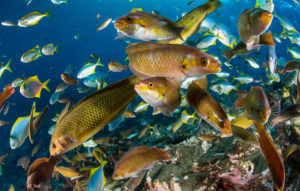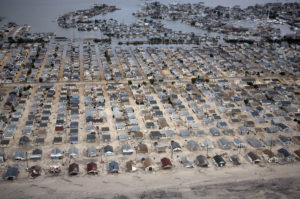In mid-March, Beijing was enveloped in heavy smog for most of this year’s crucial Two Sessions meetings of China’s top legislators, during which the 14th Five Year Plan for economic and social development was approved. With this being the first FYP published since China committed to carbon neutrality, its climate and energy targets received the lion’s share of international attention. But the ocean also has far-reaching implications for international relations and governing the global commons. And the chapter on it in this year’s FYP contains language suggesting the extension of China’s environmental ideas overseas.
Editor’s note
“Harmony between humanity and the ocean, win-win cooperation, and pushing forward with conservation of ocean ecologies,” were mentioned in the chapter introduction. This contrasts with the 13th FYP, where the language focused on developing the ocean economy and ocean resources. One notable change in this year’s document is the call for “sustainable distant-water fishing” (DWF) – the word “sustainable” was missing five years ago.
The development of DWF was first mentioned in the 12th FYP, published in 2011, and the country’s capacity has increased rapidly ever since, now far outstripping all other countries. China’s DWF fleet operates in the waters of 40 countries and regions, and on the high seas of the Pacific, Indian and Atlantic oceans, as well as in Antarctic waters.
Illegal, unreported and unregulated (IUU) fishing by Chinese vessels has become a matter of international concern. Last year, China announced its first self-imposed moratorium on some high seas fishing, but how it will make this sector “sustainable” next is anyone’s guess. A 14th FYP document specific to the fishing industry, currently being drafted, is expected to provide more answers.

When it comes to international relations, there has been a shift from “protecting [China’s] ocean rights” in the 13th FYP to a more active “in-depth participation in global ocean governance”, promoting the establishment of a “fair and reasonable international ocean regime” and the development of “blue partnerships” and an “ocean community with a shared future for mankind.” According to Liu Nengye, director of the Centre for Environmental Law at Macquarie University, “China used to focus on cooperation with littoral [coastal] states, but as its capabilities in ocean industries such as ship-making and distant-water fishing have expanded, it has acquired the ability and experience to participate in the setting of international rules. The change in language could be seen as an intensification of the ‘marine world power’ strategy.”
On polar governance, the 14th FYP Outline also proposes an “Ice Silk Road” shipping route in the Arctic, alongside increasing capacities to participate in governance and utilisation of the Antarctic. In 2017, China hosted Antarctic Treaty talks for the first time, and in 2018 published a white paper on the Arctic, which Liu regards as landmark for China’s involvement in polar governance. He says that while there are international calls for protection of the poles, and in particular the Antarctic, China stresses a balance between protection and utilisation, and he sees the language in the 14th FYP Outline as a steady continuation of China’s polar policy.
When it comes to governance of the ocean environment, the Outline calls for more cooperation with other coastal states on monitoring, protection and research, and better study and assessment of strategic deep-sea resources and biodiversity.
China has acquired the ability and experience to participate in the setting of international rules.
Meanwhile, at home, China will bolster controls of land-source ocean pollution, with river basins, river mouths and coastal waters to come under unified management with a so-called “land–sea coordination” approach, and the scope of caps on land-source pollutants to be expanded to ensure river water quality. Ultimately, this work needs to be reflected in improvements to coastal environments and ecologies, and in five years the Ministry of Ecology and Environment will assess progress as part of a national “Beautiful Bays” campaign. This will look at water quality, as well as the recovery of marine life and habitats and the protection and restoration of natural coastlines.
According to the ministry, the Beautiful Bays campaign will feature as a target in the special 14th FYP for ocean environmental protection – the first such document to be drafted – with all 1,467 of China’s ocean bays to be certified by 2035. Improving the environment in Chinese waters is also of benefit to the global ocean.
Expert analysis says compared to the 13th FYP, the new plan signals a shift from focusing on domestic marine governance to constructing an “ocean community with a shared future for mankind”. In the coming five years, the progress of this shift will be closely watched from across the world.








